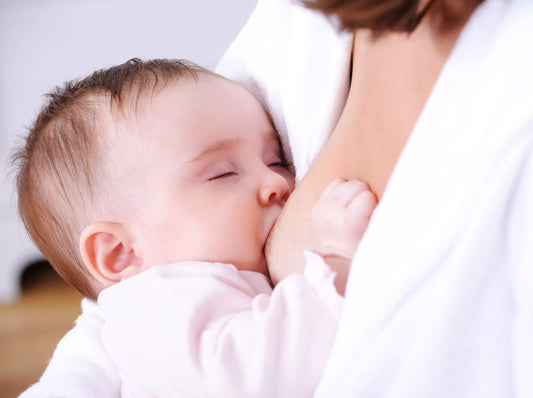Thinking breastfeeding just happens naturally is misleading, as this can make new mums feel as if something is wrong with them. The truth is that experiencing difficulties, especially during those first few days, is perfectly normal.
Valentina De Pietro, a midwife who specialises in breastfeeding and lactation consultancy, offers practical advice on how to overcome the most common issues which arise and come out on top!
First thing to learn: how to breastfeed correctly
Mum’s positioning and baby’s comfort when breastfeeding are both crucial factors in helping your newborn latch on properly.
Mum’s arms and shoulders should be relaxed whilst holding her baby. Never lean forward to breastfeed, you should always bring your baby close to your breast.
A nursing pillow can be a great help with this, offering a comfortable support to both. It reduces muscle tension in mum's (or dad's) arms, shoulders, and neck areas, while your little one sucks more comfortably. The most common breastfeeding positions newborn when using a nursing pillow are cradle and rugby.
A good attachment shouldn’t cause discomfort or pain. If either of these occur, it means your baby isn’t latched on properly, e.g., baby's mouth is not open wide enough.
Once your baby is in position, bring them closer towards your breast, making sure that their mouth is in front of your nipple.
Your baby’s mouth should be open wide while sucking, so as they can latch onto most of your areola and nipple. Attaching only onto a small area with a shallow attachment may cause pain to mum and result in poor breast milk intake for baby.
The correct way for a baby to attach to your breast is with a deep latch, with their mouth wide open, their lips open and not folded, their chin resting on your breast, and your baby's nose and forehead facing upwards.

If you experience any discomfort when breastfeeding (even and especially during the very first few days), it’s very important to ask for advice for breastfeeding from an experienced specialist, who’ll be able to show you where you’re going wrong. By seeking breastfeeding help, you’ll be able to resolve the problem immediately.
How to recognise your baby's feeding cues?
During those first few days, it’s important to spend time observing your baby in order to learn their newborn feeding cues. Being in tune with your baby’s cues will help you intervene before they become fussy and start crying.
These newborn hunger signs are divided into two groups: early hunger cues and late hunger cues. What are they?
Early newborn hunger cues:
Your baby brings their little hands up to their mouth, looking for your breast and wiggling their head performing a 'pecking' type movement with their mouth. When these cues appear, bringing your baby closer to your breast may help calm them during the feed.
Late newborn hunger cues:
Crying is the most common sign of this category. At this stage, it’s advisable to hold and try to calm your baby before starting a feed, as a fussy baby may show more discomfort when latched on at the breast. Breastfeeding is a very intimate moment, which requires a great deal of calm.
Pain from breastfeeding: breast engorgement, sore cracked nipples, mastitis and how to solve them
When breastfeeding, it’s only normal to experience a few problems, which can be resolved with professional advice. The most important thing is not to become discouraged.
Sore cracked nipples
The most common difficulty mums face when breastfeeding is sore cracked nipples (sometimes referred to as nipple fissures). What are they and how to recognise the signs?
Nipple fissures are small cracks or cuts, with or without blood present, on the nipple. The cause of sore cracked nipples is poor attachment, i.e., the baby is feeding only from the nipple and not from a larger portion of the breast which also includes a wide area of the areola.
Breastfeeding will prove to be painful and uncomfortable, and your baby will not be taking in enough milk.
How to treat sore or cracked nipples resulting from breastfeeding? Firstly, seek advice from an experienced breastfeeding professional to ensure your baby is latching on properly.
Koala Silver Cups (silver nipple shields), which have extraordinary healing properties, are a great aid in soothing and treating sore cracked nipples.
Breast engorgement
Breast engorgement is characterised by warm, red, hard, tight, and painful breasts, with possible onset of a high temperature. The cause is milk accumulation in the ducts, which leads to inflammation.
How to ease breast engorgement?
- Apply a warm flannel to the affected area
- Vary positions of your baby to ensure your breast is drained properly
- Apply a cold compress
It’s very important to continue to breastfeed despite the pain you’re experiencing.
Mastitis
Mastitis is a breast infection. The signs are when an area of your breast becomes red and your breast feels hard, hot, and painful.
It’s advised to breastfeed your baby from the infected breast frequently and also to drain it manually and by gently stroking from the top of the breast towards your nipple.
Antibiotic treatment can be prescribed if necessary from your doctor, if other methods for removing the stagnant area of milk prove ineffective.
Breast massages also help to loosen any blockages and also help with the healing process.
Tips for a pleasant breastfeeding experience
During the early days, it’s best to choose a quiet place for nursing your baby, where you won’t be disturbed.
The room temperature, an intimate and familiar environment, and a comfortable and convenient location for both mum and baby, all provide many benefits.
Observing and getting to know each other, as well as understanding your baby’s cues are important.
The post-natal period is a time of becoming acquainted with your baby as you get to know each other better, which is why creating a comfortable area of the house dedicated to breastfeeding helps.
These initial, more 'private' moments will then help us to be more confident and at ease when breastfeeding away from home.
A note on bottle-feeding
As we know, there are many breastfeeding benefits. However, this doesn’t mean that mums who choose not to breastfeed should be looked down upon.
There are many different reasons why some mums choose not to breastfeed, and a lot of thought will have gone into that choice. It’s therefore important that all mums receive the support they need and feel free to choose what works best for them – guilt-free.
Valentina De Pietro, Midwife and Lactation Consultant
A specialised healthcare professional, she accompanies mums on their journey from pregnancy to childbirth, supporting them from many different perspectives and offering pre-natal guidance and courses on breastfeeding and weaning.






